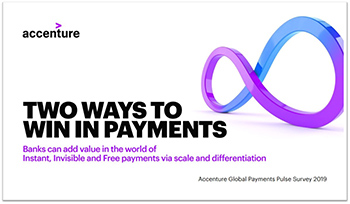Life in the Middle Ages in Europe was hard. The majority of people’s time was spent on the basics: hauling water from the well, chopping firewood and getting enough to eat. Now, that stuff has faded into the background as we get home from work, run a hot bath, turn on the central heating and heat a burrito in the microwave. For many consumers and businesses around the world making payments is still hard and time consuming. Checks have to be written, invoices reconciled and credit cards kept safe. But increasingly payments are becoming instant, invisible, and free (IIF) and are disappearing into the background as an enablement tool that we don’t even notice. When I order ahead for my Starbucks in the morning, I don’t think, “How am I going to pay for it?” It just happens. For banks, this transition is both an opportunity and a threat.
Consider regulatory moves, like in the US where the Federal Reserve just announced the development of a real-time payments service to speed up the movement of money around the economy.¹ Mobile apps from industry newcomers, like the French challenger bank Kard and US-based Zelle, allow users to make payments and send and receive money instantly. Facial recognition at Ciudad BBVA restaurants allows diners to order food, pick it up without waiting in line, and pay for it without their wallets.² Our analysis shows that consumer credit card revenue per transaction dropped 12 percent, from $1.21 in 2015 to $1.07 in 2018. These are just a few of the indications that IIF payments are on the near horizon with the potential to both displace traditional banks and compress their revenue.

The 240 banking payments executives we talked to recently see this, too. Seventy-eight percent of them see payments as already being instant or becoming instant over the next 12 months; 73 percent believe the same for invisible payments. Based on our research, IIF payments are likely to shrink the payments revenue pool by 15 percent by 2025—in other words, a big threat to established players. We expect that squeeze to come from card displacement by real-time, account-to-account payments, competition from non-banks and digital payments attackers, and continued pricing compression. However, despite revenue compression, the volume-value trade-off is still positive at the macro level, and we expect the global payments revenue pool to grow at around five percent a year, creating a $2.5 trillion market by 2025.
To counter the twin threats of price compression and aggressive new entrants, incumbent banks must focus on a two-fold response. First, renovate and scale payments technology to drive down costs and ensure that their bank-specific volume/value trade-off remains positive. This includes replacing outdated payments hubs with modern cloud-based systems and also having a relentless focus on automation and straight-through processing with an aspiration of zero marginal cost transactions.
As the payment itself becomes IIF, then banks also need to differentiate themselves by adding value around the core payment—adding a signal to the carrier wave of the underlying transaction. This could mean a better user experience, more value-added services like rewards and embedded credit, or getting into the business of running payments platforms for retailers and other partners on a white-label basis.
A common element in both driving down costs and improving the value added of payments is data. Banks are in the privileged position of not dealing in probabilities and educated guesses—instead they see the crystallised financial reality of their customers’ lives. Money in, money out, and the patterns and information content that can be derived from those flows. What customers buy, how they buy it, when they buy it, and, sometimes, why they buy it—pretty much on a daily basis. Such powerful insight gives banks the ability to build truly intimate customer relationships that can shorten the time to personalised payment offers and create hyper-relevant advisory services that make for compelling experiences. But in the IIF world, that privileged position is under threat and if banks don’t respond, they could find themselves on the outside looking in as new players enjoy the hot baths and warm burritos of a reimagined payments industry.
For more details on building scale and differentiation for the IIF payments world, I invite you to read our our Payments Pulse Survey: Two ways to win in payments.
1Federal Reserve, “Federal Reserve announces plan to develop a new round-the-clock real-time payment and settlement service to support faster payments” 8/5/2019
2BBVA, “BBVA launches its ‘invisible payments’ strategy” 3/192018











